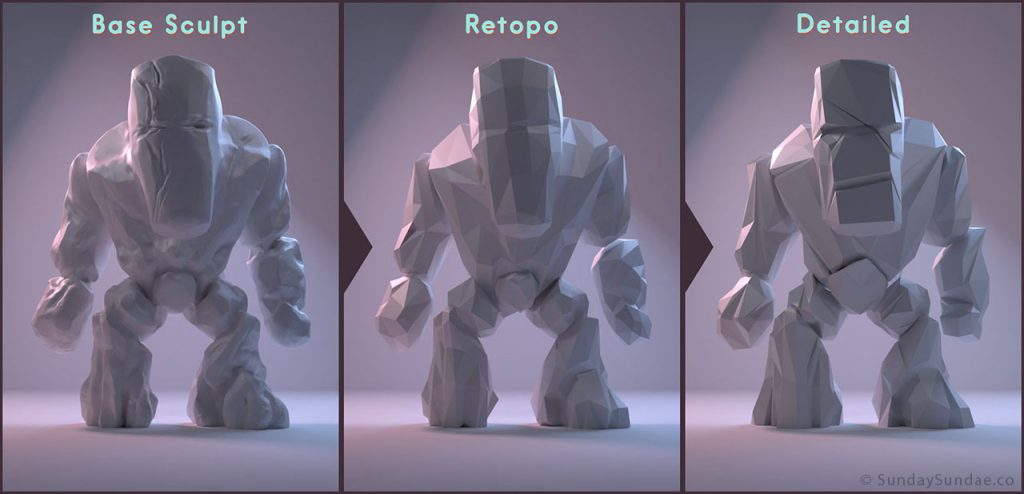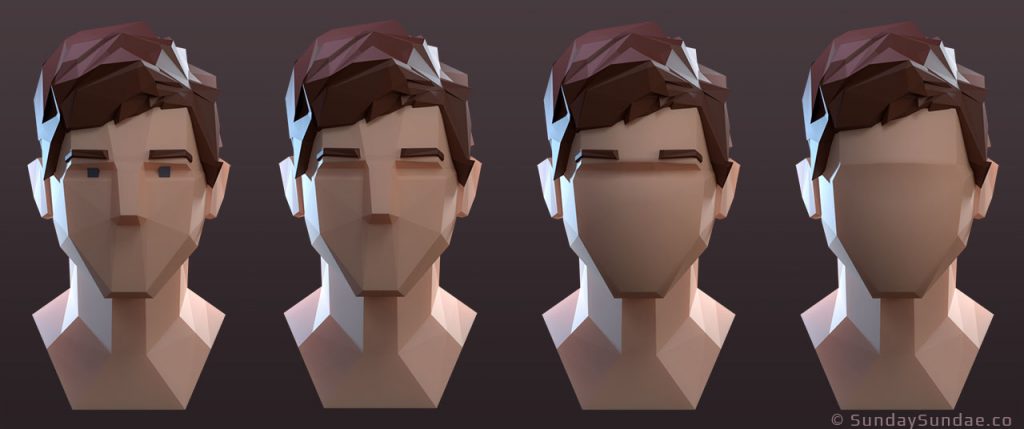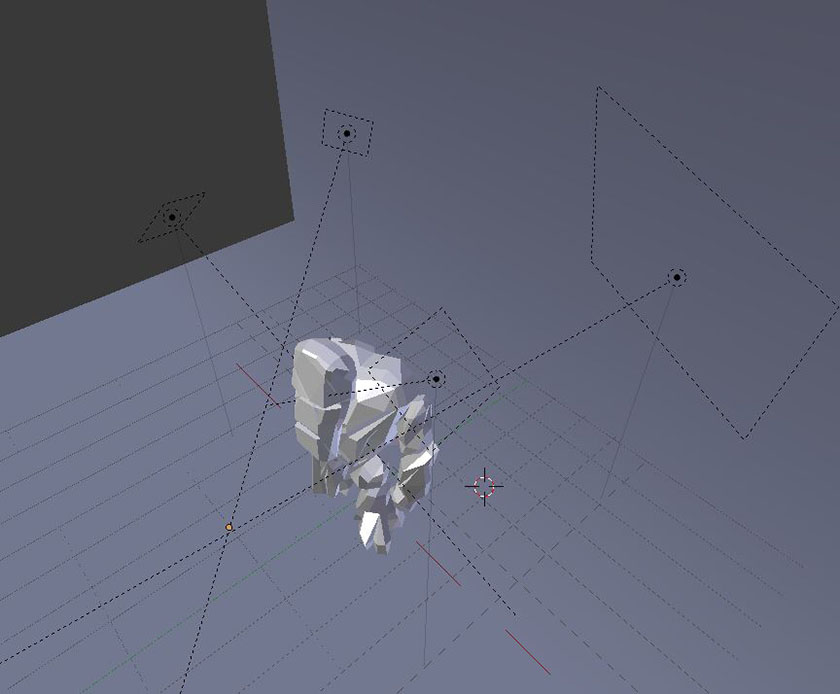Low Poly Character Design
- Transfer

A character is a person. Without history, there is no personality. Every good character starts with a story, and character design should tell the story.
In my previous article, How To Make Low Poly Look Good, I said that the main goal of low poly (low poly) design is to convey the message through the least number of forms.
This is especially true when you create a low poly character. You need to tell a story using as few forms as possible.
The concept outlined below is suitable for the character design of a game, film, illustration, or any other personal project.
I will work at Blender . Maya, Max, and other 3D editors have similar tools, so don't worry about that.
Outline character
Character design as a whole deserves a separate article, so here we will not go into it, but at least consider some basic concepts that will help us in the future.
Before starting to create a character, we need to decide who and what the character will be.
It is not necessary to write a whole story about him, just think about what defines your character.
But does this really need to be done if we only want to post some beautiful images on Artstation? Actually, no, but because of this, there are mainly models like “busty warrior” and “man in an epic space suit” .
Of course, there is nothing wrong with them, but we would like to avoid the stereotyping of our characters.
Usually you don’t need to go into details, but the more information you have about the character, the more support you will have in the design process.

What type of character are we creating? What happened to him, what will happen? What situation is he in? What is his social status? All these are fairly general questions, but they are easy to answer, and they will allow the character to be developed by asking more detailed questions.
Design
I treat low poly as removing as many details as possible without losing the essence of what we are creating.
That is why I consider it important to first outline the character, and only then dive into the design process.
If we limit ourselves to the number of polygons and textures, then we need a very clear understanding of what we want to show.
Although we want to simplify the model as much as possible, we still need to maintain enough forms to convey its expressiveness. There are many ways to convey character expressiveness. This does not necessarily mean that he needs eyes. Expressiveness can often be conveyed through movement, colors and shapes.
We want to add details only where they are really important. Let's take a look at a simple example:

As you can see, to show a character, we need very few traits. We do not even need brushes, feet and even a face, and yet we understand that this is a woman in the service. Perhaps this is a stewardess or a policeman?
Here is another example:

The figure shows 4 levels of difficulty - from a face with a nose, eyes and eyebrows to almost absent features.
Nevertheless, it is obvious that in each image a young man is captured. Here we need to make a decision: how much information is REQUIRED to convey our message.
Personally, I choose a person without a face here. If I do not need to create expressive facial expressions for him, then I will most likely focus on the faceless version. It allows the viewer to engage his imagination and adds a sense of mystery.
We’ll discuss the forms below, but before we get started, I’d like to digress briefly so that you understand what low poly really is.
Low Poly and cartoons
Don’t worry, we will soon return to low-poly design.
Low-poly graphics usually go hand in hand with cartoons. In fact, I believe that low poly graphics is a kind of cartoon, or at least its close relative.
I mean, cartoons usually use simplified forms, exaggerated and with bright attractive colors. There are more sad variations, but they are still based on these fundamental properties of the cartoon.
One studio made a special contribution to the way almost all cartoons look today. And you know which studio I mean ... of course I'm talking about Disney.

Disney Studios has always been able to masterfully take the most absurd concepts and turn them into something that we love and believe in.
Let's take a look at this from a distance. Mickey Mouse is a talking mouse, wearing only forty-five shorts and boots. Nevertheless, it does not seem strange to us, it just makes it fun and memorable.
His friend Goofy is a dog, and Mickey also has a pet dog named Pluto ... Hmm, why isn't Goofy a pet dog? He is a dog, like Pluto, but why doesn't this bother us?
Each talking character is given clothing that gives him a social status, that is, they are intelligent and civilized. Pluto is considered a pet, and therefore he does not have clothes, only a collar.
This is an excellent example of how artists define each character's social status and embed it in design.
I strongly recommend that you take a closer look at the work of Disney and other studios that you like and learn how they display their characters.
Shapes and silhouette
I remembered Disney because this studio very well creates a design of clear, readable forms.
It will be right to start with a silhouette. Having come up with a character’s idea, start sketching out approximate shapes and experimenting with proportions and postures.
If you draw poorly by hand, I can advise you to draft forms in digital sculpting software, for example, in Zbrush or Blender. It will allow you to quickly sketch out the basic forms.
Personally, I prefer sculpting, because it allows me to twist the model and look at it from different angles. Having completed the model, we can use it as a model for character modeling.
A good trick is to identify the most important character traits and exaggerate them ( STRONGLY ).
In the general case, it is worth exaggerating so that the character does not look stupid. Then, if possible, downplay the less important features. This will create simplicity, but at the same time add complexity to the character.
Take, for example, Jessica Rabbit from the movie Who Framed Roger Rabbit.

Design process
Now let's take a break from the lectures and create a low-poly character! After that, we will look at technical tips for modeling low-poly characters.
We will make a stone character.

He may be the enemy or boss in a fantasy video game, most likely living in the mountains.
We can imagine that it was formed from a volcano filled with dark magic, but in this case I will have to add a little sparkling magma to the cracks.
You can already see that we are starting to add details showing who and what the character is, based on his background. An idea with magma came to me when I had already completed the project!
Well, let's deal with our character. I wanted to create a stone monster consisting of cobblestones. As if almost all forms could be an arbitrary rock formation randomly looking like a character.
I started with a very rough sketch to at least have an idea of what I want to do.

Ugly but useful concept art
As you can see, there is nothing special about it, and I would not show such a sketch to anyone. We just need it as a reference in order to use it in a 3D editor.
I started experimenting with this quick sketch as a reference for ZBrush, until I got a result that can be used as a basis.
At this stage, you should experiment and try different shapes to get a beautiful readable silhouette.
But be careful, it’s very easy to get stuck on the details and forget about the big picture. Remember that we only use it as a reference for this model, so you can take care of the details later.

Stages of creating a stone monster
Having finished sculpting the foundation, you can begin to create a basic mesh that you can work with (the sculpture may be too high poly and inconvenient to work with). In the future, we will consider techniques to solve this problem. This process is called retopology .
Having created a clear low-poly mesh, we begin to add details and remove unnecessary elements. Of course, you can leave everything as it is, but personally, I prefer to work and move and “crumple” the vertices a bit to get a more pleasant result. Below we will dwell on this in more detail.
This is how my design process for low-poly characters looks in general. Sometimes I skip the stage of the basic sculpture and just start with a cube or something similar; it's faster, though harder.
Shrink effect
This is a subjective topic, so if you do not agree with the foregoing, this is quite normal.
What do I mean by the shrink wrap effect? Imagine that you have a region of evenly distributed polygons, and you wrap it around your object.
This creates evenly distributed polygons wrapped around the object.

On the left - a model with the effect of "heat shrink", on the right - "wrinkles" and creases are added to the model.
Although sometimes it is suitable for creating a certain style, such a model can easily seem rather unremarkable and flat.
To make your model stand out, it is better to avoid this and approach the character individually.
Usually I start with the shrink wrap effect, and then go deeper into the work and start to remove the edges that seem optional, or add the edges where I need more details. Look carefully at the images shown above and below and notice what I did.

By removing and adding details, you can help the viewer's eye move through the most important areas and filter out less important ones.
Materials
Many quite high-quality low-poly images fail at the stage of creating materials and lighting.
When creating simplified models, it is easy to be fooled that materials should be as simple as possible. I strongly disagree with this.
Combining a low-poly model with realistic or semi-realistic materials and lighting, you can get a very interesting and deep image.
Here is an example with our woman. On the left, only the diffuse shader is used. Compared to the final result, it looks rather flat and boring.

For the skin in the final image, I used the Diffuse , Glossy and Subsurface Scatter shaders . The image below shows the shader graph. When working with skin, a subsurface (subsurface scattering) is especially important. It can also be applied to other objects, giving them a softer appearance.

The dress consists of Diffuse , Glossy and Velvet . I used velvet (velvet) to add a deeper and cooler shade to add variety.

Lighting
Lighting is as important as anything else. And it greatly depends on the scene, the necessary mood, the shape of objects, etc. When it comes to lighting, you need to try many different options.
I usually start by adding ambient light as the base light. It can be inside, outside, the main thing is that it matches the image. The sphere will create a good overall image base.
Then I add three simple point sources of light - the main light that fills the light and the back light. Try to experiment with the colors of these sources, usually it is worth making the fill light warmer and the back one cooler, we constantly see such a pattern in films.

Arrangement of light sources for a stone monster
After that, I move the sources around the scene or add more if I need to fill in some areas.
I recommend that you study the images you like with stylized lighting and try to reproduce it to understand how to adjust the light.
To make your image look professional, you need to achieve a good balance between materials and lighting. You need to constantly practice.
Retopology
I said above that we will consider the retopology of our character.
The idea is that we have as a basis a high-poly model or a chaotic mesh sculpted by sculpting. We use this mesh as a support to start drawing geometry that you can work with.
Here are some of the tricks I use;
Retopo Flow:

Contours tool in TopoFlow
Blender doesn't have many good tools for creating geometry on top of another object, however there is a handy plugin called Retopoflow , which can be downloaded for free from here .
Retopoflow has some great tools for creating a clean sculpture-based topology.
Shrink Wrapping:
Another trick, which is implemented even faster: create a cube , subdivide it a couple of times or until we get a resolution suitable for our object. We place the object so that it completely covers the mesh created by the sculpting and use the Shrinkwrap modifier , taking the sculpture as a reference.
This will literally perform “shrink” the cube around the sculpture, quickly giving us the desired shape, but with the geometry suitable for the job.

Subdivided into parts, the cube clasps the hand.
Shrink wrapping works best if you use different shapes for the character, I do not recommend trying to “fit” the cube as a whole on the whole character, because this will distort it a little. For example, create one shape for a shoulder, arm, torso, etc.
If an object has more complex shapes, then perhaps you should not start with a cube, but instead model a rough shape that represents the finished object, but ensuring that the edges are correctly positioned. Then perform a shrink wrap around the sculpture.
There are other ways to do this, but in my case, these two methods cover all aspects necessary for the retopology of low-poly objects.
To summarize
I hope this article has given you useful information and has become a source of inspiration for your low-poly character! I tried to make it concise, but informative, if I missed something, then report it in the comments.
